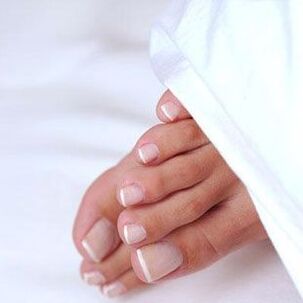
Summer provides us with wonderful opportunities for relaxation and beauty. After all, when, if not in the summer, can we afford a fashion show in beautiful open shoes, demonstrating to others our impeccable pedicure and beautiful legs? And how much pleasure it gives us to walk barefoot on the warm and soft sand!
Unfortunately, all these summer charms can end up being quite sad for our feet and nails, since by opening them we run the risk of contracting such an unpleasant and extremely insidious disease as a fungus. And most of the time it is our nails and feet that are affected. Also, you can get infected with nail fungus not only on the beach or in a public shower.
You can get this disease even on public transport, or just walking down the street in open shoes - slippers or sandals.
Unfortunately, the consequences of a fungal infection on the nails, and indeed on the entire human body, are quite serious, so you should not start this disease.
Therefore, it is important to know the symptoms of the infection and start treatment in a timely manner. And for this you need to find out what constitutes a toenail fungus.
what is onychomycosis
Fungi, as a class, belong to lower plants that form filaments of mycelium and spores. It is with the help of spores that fungi reproduce, and also spread in the external environment. You will be surprised, but scientists know of more than 300, 000 varieties of fungi, and about 100 species of them can cause skin and nail diseases in humans.
Since they also reproduce by spores, any crumb from a diseased nail or a piece of skin from the heel or foot of a diseased person is enough to become infected with such fungi.
Fungal infections of the nails (onychomycosis) can be caused by several types of fungi. Accordingly, the signs of infection will be different, and the means of getting rid of them, too.
dermatophytes
If you notice small yellow spots or streaks appear on your toenails, streaks of a lighter shade of white or gray appear on your nails, and the edge of the nail recedes and turns yellow, you most likely have been infected with dermatophytes.
The degree of infection with dermatophytes can be easily determined by the same stripes and spots: the brighter they are and the closer they are to the center of the nail, the stronger the infection. So if these streaks and spots are located closer to the edges of the nails, then the infection has not progressed too far and the disease can be stopped in time. But in no case should it be delayed! After all, if left untreated, not only the toenails are affected, but also the skin around them, and the nail plate will eventually turn completely yellow and dull.
yeast fungi
If the toenails become uneven, grooves and "waves" appear, if at the same time the nail gradually turns yellow and loses its density, becomes very brittle, thin, begins to lag behind the nail bed, most likely is that it has become infected with yeast. In this case, the degree of infection is determined by the color of the nail: the more yellow and even brownish it becomes, the more the lesion progresses.
The defeat of yeast toenails usually begins with a slight thickening of the nail folds, which eventually swell and turn red. Pressing on these swollen rollers is quite painful. Later, pus may appear on them, which, if it gets on the skin, can cause further infection. If no action is taken, then over time the nail may gradually bend and change color, shallow brown grooves will appear.
molds
If a person's nails, like his whole body, were weakened for a long time due to a long illness, and then quickly changed color: they turned yellow, blue, green, brown or black, or dark or even black dots or spots appeared on the nails - most likely, there is an infection with mold fungi.
Fortunately, such an infection does not penetrate very deep into the structure of the nail plate, and compared to the previous types of fungus, it is treated quite quickly - from one to two months.
Consequences of the disease
However, these are all just outward signs of the disease, and if no action is taken, toenail fungus can spread throughout the body, especially when it comes to dermatophytes or molds. Over the course of a year, and sometimes several years, the fungus slowly destroys the nail plate, fills the entire nail and penetrates the nail bed, and after a while it spreads from the feet to the hands, first affecting thumbs and then everyone else.
Spreading and taking root in the human body, the fungus significantly weakens the immune system, which contributes to the appearance of various allergic reactions and the exacerbation of chronic diseases.
If a person does not start treatment at this stage, the internal organs are damaged. Particularly susceptible to such an infection are people who have a bad habit of biting their nails.
Therefore, it is extremely important to recognize the disease in a timely manner and initiate timely and appropriate treatment. Naturally, only a specialist can prescribe it, who will conduct the necessary examination and prescribe the appropriate drugs that affect exactly the fungus that affects your body.
Auto diagnosis
You can try to diagnose your own nail fungus yourself if you suspect something is wrong with your appearance, feel itchy and dry skin.
To do this, you will need the most common potassium permanganate. You need to turn it into a watery solution and lower your legs into it. After a few minutes, your nails will turn brown, but the fungal lesions will remain mild.
In this case, you definitely cannot do without consulting a doctor. And it is better not to delay it!
















